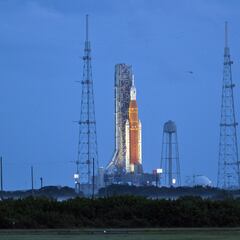NASA’s Perseverance rover finds organic matter in ancient river on Mars
The ground-breaking explorer has identified evidence which suggests that the red planet may have previously housed an enormous lake.


NASA’s Perseverance rover is one of the most sophisticated devices the agency has ever sent into space and is currently in the middle of its second campaign on the surface of Mars.
The mission’s holy grail would be to find some evidence of historic life on the red planet and a recent discovery suggests that Mars may have been habitable in the past. Scientists are hoping that the rover will uncover ancient microbial life on the planet.
Perseverance has collected and analysed a dozen samples and one of the most recent was found to contain significant quantities of organic matter. The sample was taken in the Jezero Crater, which scientists speculate may once have been a vast lake with a connecting river delta.
“The rocks that we have been investigating on the delta have the highest concentration of organic matter that we have yet found on the mission,” said Perseverance project scientist Ken Farley, from the California Institute of Technology in Pasadena.
Was there once life on Mars? @NASAPersevere’s latest samples could hold clues to answering this question.
— NASA Astrobiology: Exploring Life in the Universe (@NASAAstrobio) September 15, 2022
Further analysis on Earth is needed to confirm, but one thing is sure – Perseverance has succeeded in capturing the rich samples we hoped for: https://t.co/D6VlYQWeLi pic.twitter.com/Ep586KvId3
Did the Jezero Crater used to support life?
After 18 months on the surface of Mars, the Perseverance project is now focusing in on the Jezero Crater as an area of particular scientific interest. Since 7 July the rover has taken four samples from the crater and scientists have made a number of crucial findings.
The 28-mile-wide crater with a fan-shaped delta is thought to have been the point where a river converged with a major lake. Although any water disappeared millions of years ago, scientists hope that the sedimentary rock which forms the base of the crater could contain valuable information about what used to be there.
“The delta, with its diverse sedimentary rocks, contrasts beautifully with the igneous rocks – formed from crystallization of magma – discovered on the crater floor,” Farley explained.
“This juxtaposition provides us with a rich understanding of the geologic history after the crater formed and a diverse sample suite. For example, we found a sandstone that carries grains and rock fragments created far from Jezero Crater.”
The rover is equipped with an instrument called the Scanning Habitable Environments with Raman & Luminescence for Organics & Chemicals, or SHERLOC for short. This allows scientists to study the rover’s samples remotely, but they do hope to bring them back to earth eventually for further tests.
Perseverance has been depositing samples at a drop-off location on the surface of Mars, which will then be collected and returned to Earth in a future mission. Although we are some way from finding conclusive evidence of life on Mars, those involved in the huge project are enthusiastic about the possibilities that Perseverance and its latest discoveries offer.
Related stories
“I’ve studied Martian habitability and geology for much of my career and know first-hand the incredible scientific value of returning a carefully collected set of Mars rocks to Earth,” said NASA’s Jet Propulsion Laboratory directo Laurie Leshin.
“That we are weeks from deploying Perseverance’s fascinating samples and mere years from bringing them to Earth so scientists can study them in exquisite detail is truly phenomenal. We will learn so much.”

